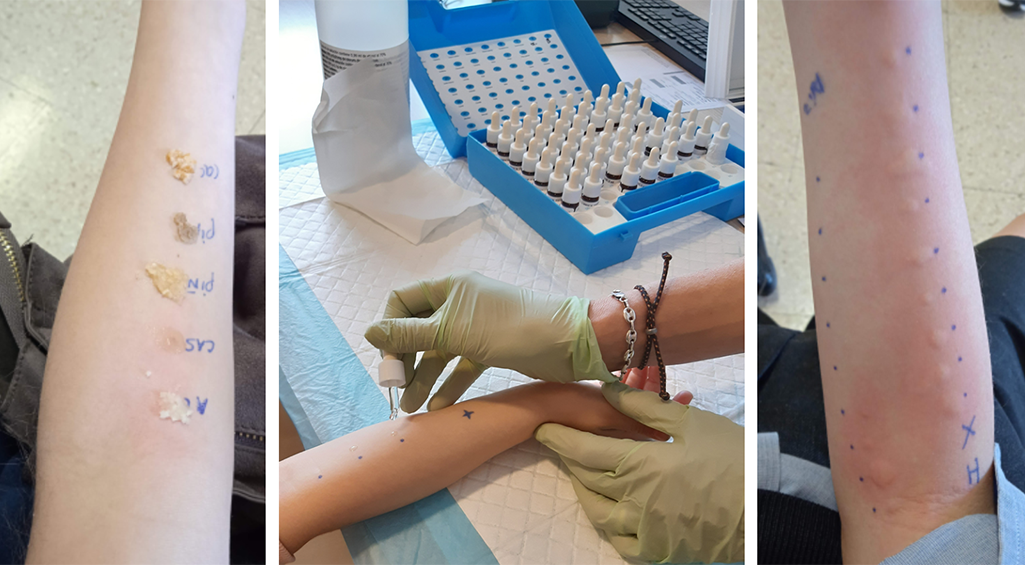
“Allergy is the main cause in 80% of children with asthma”
We spoke with Dr. M. Carmen García Avilés, an expert in allergic diseases, to find out in depth what they consist of and how to act against them.
The prevalence of allergies is on the rise, particularly in developed countries. Why?
It is true that there is a progressive increase in people suffering from a more or less serious allergic disease - this could be due to genetic factors, but also more particularly to environmental factors that encourage the development of these pathologies: life style, diet and environmental pollution, amongst others.
What are the most common allergies in Spain?
According to the latest data, the most frequent reasons for allergology consultations were hay fever (54%), bronchial asthma (23%) and allergy to medicines (17%). At times, allergy symptoms can overlap and cannot be distinguished from other non-allergic diseases, causing both patients and the specialists themselves to become confused. For this reason, it is very important to carry out a good medical record to detect the frequency and length of the symptoms, possible allergens that trigger the symptoms, personal background and family members with atopy, response to the treatments administered to date, etc.
Do all allergies appear in the same way?
Allergic disease can begin at any time in your life and it can take on different forms. It can affect the respiratory tract, causing rhino conjunctivitis and bronchial asthma; or the skin, producing allergic contact atopic dermatitis, hives or angiooedema. There are also allergies that affect the digestive tract; and when they affect more than two organs or systems, this can cause the most serious case: anaphylaxis. The allergens responsible for these symptoms are also very varied.
Which of these allergies are most complicated to treat?
From my point of view, the most serious case regarding immediate reactions, which are the ones that occur a few minutes after exposure to the allergen, is anaphylaxis or anaphylactic shock to a food, medicine or sting by a hymenoptera. These are unpredictable reactions and they appear suddenly, with no warning.
How are allergies treated?
The most important element in an allergic disease is to identify the causal agent of the symptoms in order to completely avoid them. But this is not always possible to do, and this is when a symptomatic treatment must be carried out, either at the specific moment of the reaction, or over an extended period of time. In some very specific cases, desensitization to a food or medicine may be carried out, which consists of progressive administration of the allergen in order to become tolerant to it. There are also new groundbreaking therapies such as biological drugs that can be useful for diseases such as serious asthma, chronic hives and atopic dermatitis.
How have diagnosis techniques progressed?
The diagnosis of allergic diseases by way of a patient’s skin test dates back to 1873. In recent years, new in vitro diagnosis techniques that do not endanger the patient have been fostered; the best known method is the determination of the specific IgE antigen, quantifying an individual’s degree of allergy.
Does technology play an important role in allergist consultations?
Technology and health have been growing and moving forward together to make our lives increasingly easier. Technological development has helped to create new drugs and treatments, improving medical research and simplifying processes. Technology is important in medicine, not only due to the development of these types of tools, but also due to the benefits that it brings with it, such as an increase in accessibility to medical care.
Can allergies be prevented using genetic components?
Allergic diseases have a clear hereditary component. Several studies have confirmed that children of parents who suffer from allergic diseases (food, asthma, allergic hay fever or eczema) have a greater risk of suffering from this type of disease. This predisposition must be encouraged by environmental factors that push the balance towards tolerance or towards allergy. In the United States, in recent years, several studies have been performed with children who have a high risk of suffering from peanut allergy where they have tried to implement steps to prevent this allergy. Although it could seem shocking, exposing these babies to peanuts can have a favourable effect for the development of a tolerance to the food.
How should allergy sufferers face up to the challenge of spring?
Once a patient knows that they have an allergy to a certain type of pollen, preventive steps are usually effective. In addition, people must think ahead and always keep the medicines, both preventive and symptomatic, recommended by the allergist at hand.
What steps or habits can help an allergy sufferer to make their symptoms milder?
There are several steps to minimise the harmful effects of pollen in the springtime, such as avoiding going outside when the pollen is at its greatest concentration, keeping windows closed or using sunglasses to protect your eyes from the pollen. Clothing should also be dried inside the house and if using a car, the windows must be kept closed.
Can pollution make it more possible for a person to suffer an allergy attack?
The particles eliminated in diesel engine combustion and heating systems in cities create an unfavourable environment in plants which, to defend themselves, produce “stress proteins” that make their pollen more aggressive, with a greater potential for allergenicity. The high urban pollution levels also prevent the pollen from leaving the atmosphere, generating an “allergenic cloud,” increasing the exposure time in urban areas.
Asthma is one of the most common diseases seen in Spanish allergist consulting rooms.
link between genetic factors and environmental factors. A large amount of environmental stimuli can cause asthma or trigger an attack. Hereditary elements or atopy (predisposal to suffer from diseases such as hay fever, conjunctivitis or atopic dermatitis) are among the risk factors. Viral infections of the upper respiratory tract or the inhalation of high concentrations of aeroallergens are amongst the triggers. Some medicines can also trigger an asthma attack, along with physical exercise, cold air, environmental pollution, tobacco smoke or stress, amongst others.
So, what is the link between asthma and allergy?
In over half of adults with asthma, and in 80% of children, allergy is the main cause of bronchial asthma. Allergy can cause bronchial asthma in certain people, but not everyone who suffers from an allergy develops bronchial asthma.
 Graduate in Medicine from the University of Alicante. Is a specialist in Allergology and Clinical Immunology and a member of the Allergy to Medicines Committee of the SEAIC. She currently works at the Hospital Universitario HLA Moncloa (Madrid).
Graduate in Medicine from the University of Alicante. Is a specialist in Allergology and Clinical Immunology and a member of the Allergy to Medicines Committee of the SEAIC. She currently works at the Hospital Universitario HLA Moncloa (Madrid).




